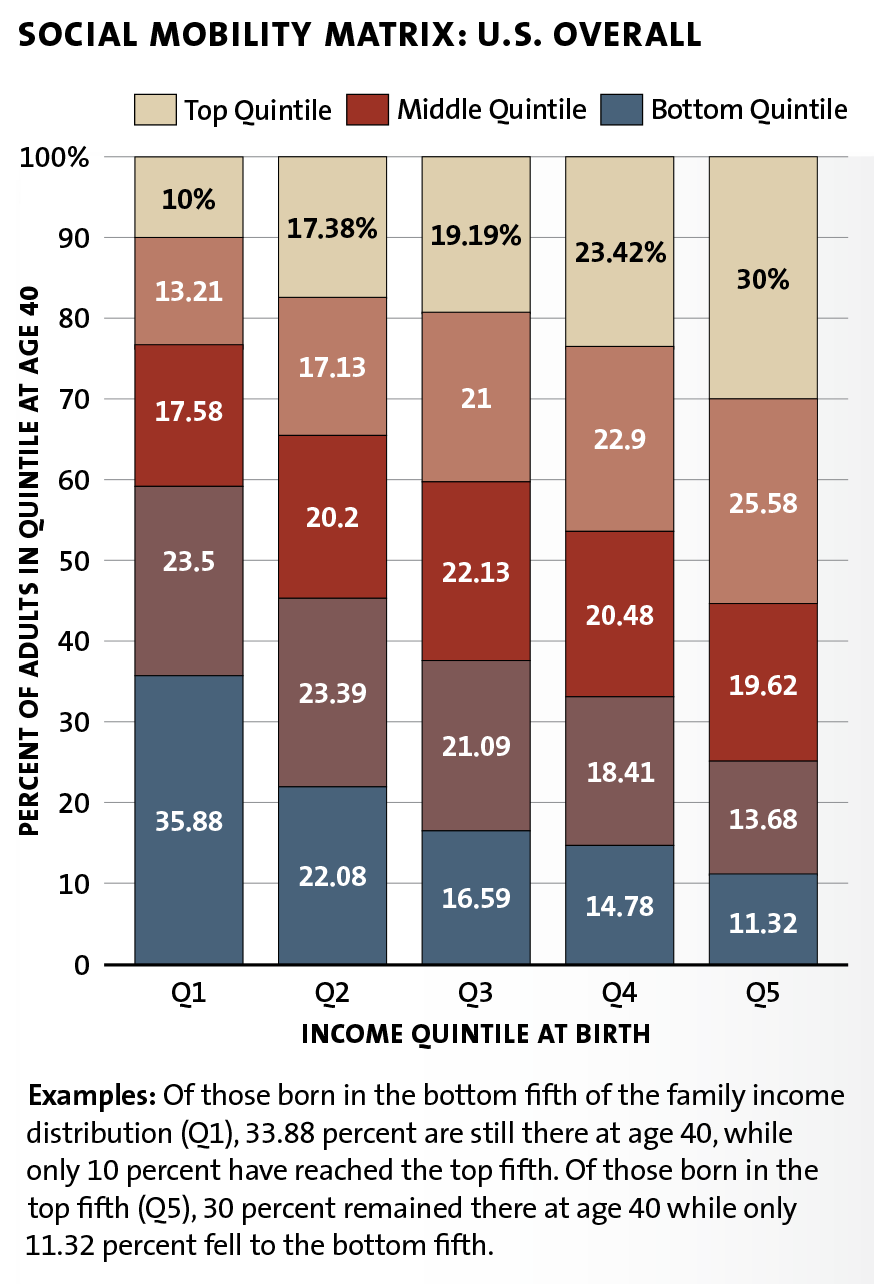Brookings scholars Richard Reeves and Isabel Sawhill have an informative article in the Milken Institute Review that provides a nice summary of the research on social mobility. “So how are we doing?” they ask.
The good news is that economic standards of living have improved over time. Most children are therefore better off than their parents. Among children born in the 1970s and 1980s, 84 percent had higher incomes (even after adjusting for inflation) than their parents did at a similar age, according to a Pew study. Absolute upward income mobility, then, has been strong, and has helped children from every income class, especially those nearer the bottom of the ladder. More than 9 in 10 of those born into families in the bottom fifth of the income distribution have been upwardly mobile in this absolute sense.
That’s good news, but “[t]here’s a catch…Strong absolute mobility goes hand in hand with strong economic growth. So it is quite likely that these rates of generational progress will slow, since the potential growth rate of the economy has probably diminished.” Furthermore, “[i]f you are born to parents in the poorest fifth of the income distribution, your chance of remaining stuck in that income group is around 35 to 40 percent. If you manage to be born into a higher-income family, the chances are similarly good that you will remain there in adulthood. It would be wrong, however, to say that class positions are fixed. There is still a fair amount of fluidity or social mobility in America – just not as much as most people seem to believe or want. Relative mobility is especially sticky in the tails at the high and low end of the distribution. Mobility is also considerably lower for blacks than for whites, with blacks much less likely to escape from the bottom rungs of the ladder. Equally ominously, they are much more likely to fall down from the middle quintile.”
But are these rates of relative mobility getting worse? “Current evidence suggests not. In fact, the trend line for relative mobility has been quite flat for the past few decades, according to work by Raj Chetty of Stanford and his co-researchers. It is simply not the case that the amount of intergenerational relative mobility has declined over time.”

Some other interesting points:
- “Interestingly, the most recent research suggests that the United States stands out most for its lack of downward mobility from the top.”
- “Pioneering work (again by Raj Chetty and his colleagues) shows that some cities have much higher rates of upward mobility than others. From a mobility perspective, it is better to grow up in San Francisco, Seattle or Boston than in Atlanta, Baltimore or Detroit. Families that move to these high-mobility communities when their children are still relatively young enhance the chances that the children will have more education and higher incomes in early adulthood. Greater mobility can be found in places with better schools, fewer single parents, greater social capital, lower income inequality and less residential segregation.”
- The Social Genome Project “tracks children’s progress through multiple life stages with a corresponding set of success measures at the end of each…Three findings from the model stand out. First, it’s clear that success is a cumulative process. According to our measures, a child who is ready for school at age 5 is almost twice as likely to be successful at the end of elementary school as one who is not…Children who get off track at an early age frequently get back on track at a later age; it’s just that their chances are not nearly as good. So this is a powerful argument for intervening early in life. But it is not an argument for giving up on older youth.”
- “Second, the chances of clearing our last hurdle – being middle class by middle age (specifically, having an income of around $68,000 for a family of four by age 40) – vary quite significantly. A little over half of all children born in the 1980s and 1990s achieved this goal. But those who are black or born into low-income families were very much less likely than others to achieve this benchmark.”
- “Third, the effect of a child’s circumstances at birth is strong. We use a multidimensional measure here, including not just the family’s income but also the mother’s education, the marital status of the parents and the birth weight of the child. Together, these factors have substantial effects on a child’s subsequent success. Maternal education seems especially important.”
Check out the full article.